
Forest, tree, foliage and cone. Drawing by Matt Strieby, 2018.
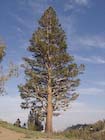
Tree on summit of Sonora Pass, California [C. J. Earle, 2008.06.29].
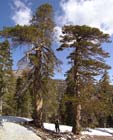
A pair of old trees on Mt. San Jacinto, California [C. J. Earle, 2004.04.10].
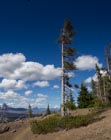
A skirted tree near McKenzie Pass, Oregon. This growth form indicates exposure to severe windblown ice and snow in the winter, with the lower part of the tree shielded within the snowpack [C. J. Earle, 2016.07.02].
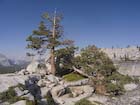
Small trees of P. contorta ssp. murrayana and Juniperus grandis at Olmstead Point, California [C. J. Earle, 2008.06.30].

Sapling above Wellman Cienega on Mt. San Jacinto, California [C. J. Earle, 2004.04.10].
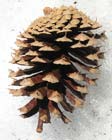
Cone about 6 cm long, also at Mt. San Jacinto [C. J. Earle, 2004.04.10].

Lodgepole and Jeffrey pine parkland below Wellman Divide on Mt. San Jacinto, CA [C.J. Earle, 2004.04.10].

Pinus contorta subsp. murrayana
(Balfour) Engelmann 1880
Common names
Sierra lodgepole pine (Kral 1993), tamarack pine, tamrac pine.
Taxonomic notes
Syn: Pinus murrayana Balfour 1853; P.contorta var. murrayana (Balfour) Engelmann 1880 [in Watson, Bot. Calif. 2: 126]; P. bourcieri Carrière; P. tamrac A Murray (Critchfield 1957).
Description
Trees to 36 m tall and 90 cm dbh, straight, little tapering; crown mostly conic at maturity. Bark scaly, not evidently furrowed, orange- to purple-brown. Branches spreading, ascending at tips. Leaves 5-8 cm × 1-2 mm, yellow-green, apex acute. Seed cones maturing in 14-18 months, shedding seeds and falling soon thereafter, 3-6 cm long, nearly symmetric, buff-brown (unlike the darker orange-brown of the other ssp.), mostly spreading, rarely in whorls, more often paired or solitary, scales thin, flexible; mid and lower apophyses mostly shallowly domed; umbo with a slender, fragile 2-4 mm spine (Kral 1993, M.P. Frankis e-mail 1999.02.28). Burns and Honkala (1990) state that compared to the other subspecies, murrayana has wider needles, substantially larger seeds, flatter apophyses, little or no serotiny, and seedlings with more cotyledons.
Distribution and Ecology
In the Sierra Nevada, Cascade and Klamath Mts. of: USA: Washington, Oregon, California; Mexico: Baja California Norte. Found in montane forests at 400-3500 m (Critchfield 1957, Wheeler and Guries 1982). USDA hardiness zone 7. Adapted to tolerate relatively frequent, low to moderate intensity fire (Burns and Honkala 1990).
Remarkable Specimens
Currently, the largest is a specimen in San Bernardino, California, measured in 2019 at 204 cm dbh and 41.4 m tall (American Forests 2021; includes photos). Former champions included one 196 cm dbh and 32 m tall, and another 185 cm dbh and 36 m tall, both located in Stanislaus National Forest, Califorina (American Forests 1996).
The oldest record is from a tree-ring chronology covering 471 years, presumably based on living tree material, collected in 1984 in Yosemite Park, California (3000 m elev.; 37° 48'N, 119° 15' W) by K. Briffa and F. H. Schweingruber (NOAA 1999).
Ethnobotany
Observations
A reasonably common and distinctive tree throughout its range. The most memorable stands that I have seen are probably those on the southern approaches to the summit of Mt. San Jacinto, where trees of exceptional size and age can be found. Some of the most pleasingly contorted specimens I have seen are in the vicinity of Olmstead Point in Yosemite National Park, with more fine trees found scattered on the open granite throughout the Yosemite backcountry. At the appropriate elevations it is also easily seen along the Sonora Pass road and along the Generals Highway in Sequoia-Kings Canyon National Parks.
Remarks
Citations
American Forests 1996. The 1996-1997 National Register of Big Trees. Washington, DC: American Forests.
Critchfield, W. B. 1957. Geographic variation in Pinus contorta. Maria Moors Cabot Foundation (Harvard) Publ. 3.
Engelmann, G. E. 1880. Revision of the genus Pinus, and description of Pinus elliottii. Transactions of the Academy of Science of Saint Louis 4:161-190 (p. 177, 181). Available from Google Books, accessed 2011.05.20).
NOAA Paleoclimatology Program Tree-Ring Data Search Page. http://julius.ngdc.noaa.gov/paleo/ftp-treering.html, accessed 1999.02.24, now defunct.
Wheeler, N. C. and R. P. Guries. 1982. Population structure, genic diversity, and morphological variation in Pinus contorta Dougl. Canadian Journal of Forest Research 12: 595-606.
See also
Arno, Stephen F. and Jane Gyer. 1973. Discovering Sierra trees. Yosemite Natural History Association. 89pp.
Farjon and Styles (1997).
Hickman (1993).
Lanner (1999).
FEIS database.








